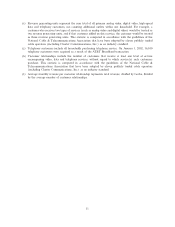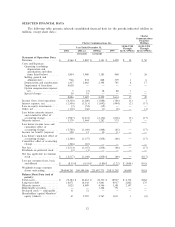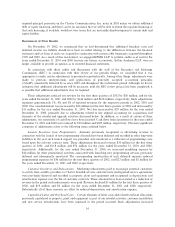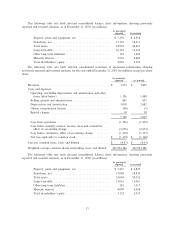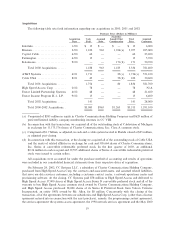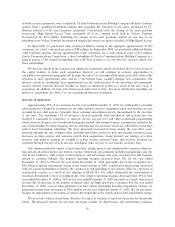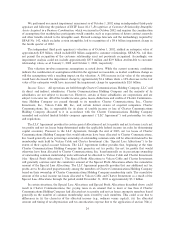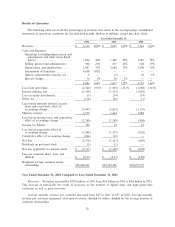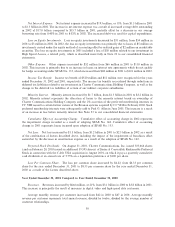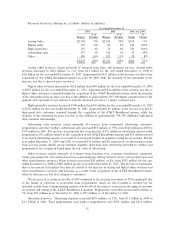Charter 2002 Annual Report Download - page 23
Download and view the complete annual report
Please find page 23 of the 2002 Charter annual report below. You can navigate through the pages in the report by either clicking on the pages listed below, or by using the keyword search tool below to find specific information within the annual report.impairment charges on franchises and interest costs on borrowed money, which increased in the aggregate by
$3.6 billion and $555 million, respectively for the year ended December 31, 2002 as compared to
December 31, 2001 and for the year ended December 31, 2001 as compared to December 31, 2000. Continued
net losses could have a material adverse impact on our ability to access necessary capital, including under our
existing credit facilities. See ""Ì Liquidity and Capital Resources'' for greater detail.
Critical Accounting Policies and Estimates
Certain of our accounting policies require our management to make diÇcult, subjective or complex
judgments. Management has discussed these policies with the Audit Committee of our Board of Directors and
the Audit Committee has reviewed the following disclosure. We consider the following policies to be the most
critical in understanding the estimates, assumptions and judgments that are involved in preparing our Ñnancial
statements and the uncertainties that could impact our results of operations, Ñnancial condition and cash
Öows:
‚ Capitalization of labor and overhead costs;
‚ Useful lives of property, plant and equipment;
‚ Impairment of property, plant, and equipment, franchises, and goodwill;
‚ Income taxes
‚ Litigation
In addition, there are other items within our Ñnancial statements that require estimates or judgment but
are not deemed critical, but changes in judgment, or underestimates in these other items could also have a
material impact on our Ñnancial statements.
Capitalization of labor and overhead costs. The cable industry is capital intensive, and a large portion of
our resources are spent on capital activities associated with extending, rebuilding, and upgrading our cable
network. As of December 31, 2002 and 2001, the net carrying amount of our property, plant and equipment
(consisting primarily of cable network assets) was approximately $7.7 billion (representing 34% of total
assets) and $6.9 billion (representing 26% of total assets). Total capital expenditures for the years ended
December 31, 2002, 2001 and 2000 (including capital items that had been received but for which payment
had not been made) were approximately $2.2 billion, $2.9 billion and $2.8 billion, respectively.
Costs associated with network construction, initial customer installations, installation refurbishments and
the addition of network equipment necessary to enable advanced services are capitalized. Costs capitalized as
part of initial customer installations include materials, direct labor, and certain indirect costs. These indirect
costs are associated with the activities of personnel who assist in connecting and activating the new service and
consist of compensation and overhead costs associated with these support functions. The costs of discon-
necting service at a customer's dwelling or reconnecting service to a previously installed dwelling are charged
to operating expense in the period incurred. Costs for repairs and maintenance are charged to operating
expense as incurred, while equipment replacement and betterments, including replacement of cable drops
from the pole to the dwelling, are capitalized.
Direct labor costs directly associated with capital projects are capitalized. We capitalize direct labor costs
associated with personnel based upon the speciÑc time devoted to network construction and customer
installation activities. Capitalizable activities performed in connection with customer installations include:
‚ Scheduling a ""truck roll'' to the customer's dwelling for service connection;
‚ VeriÑcation of serviceability to the customer's dwelling (i.e., determining whether the customer's
dwelling is capable of receiving service by our cable network and/or receiving advanced or data
services);
21


